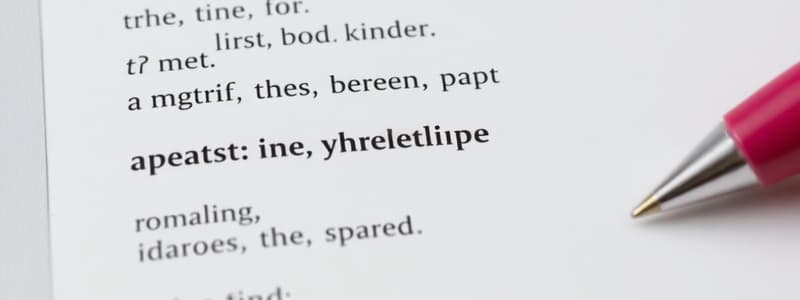Podcast
Questions and Answers
Which part of speech replaces a noun to avoid repetition?
Which part of speech replaces a noun to avoid repetition?
- Adverb
- Verb
- Pronoun (correct)
- Adjective
Adverbs typically describe nouns.
Adverbs typically describe nouns.
False (B)
What does syntax primarily refer to in the context of language?
What does syntax primarily refer to in the context of language?
word order
Adverbs of __________ describe how an action is performed.
Adverbs of __________ describe how an action is performed.
In the standard order of adjectives, which category typically comes after size and before shape?
In the standard order of adjectives, which category typically comes after size and before shape?
Which of the following sentences demonstrates the correct order of adjectives?
Which of the following sentences demonstrates the correct order of adjectives?
Identify the sentence where 'too' is used with its commonly associated negative connotation or to indicate an excess.
Identify the sentence where 'too' is used with its commonly associated negative connotation or to indicate an excess.
Formulate a sentence using at least four adjectives in the correct order to describe a car.
Formulate a sentence using at least four adjectives in the correct order to describe a car.
Which part of speech is responsible for renaming nouns in a sentence to avoid repetition?
Which part of speech is responsible for renaming nouns in a sentence to avoid repetition?
Adjectives typically follow the nouns they modify in English sentences.
Adjectives typically follow the nouns they modify in English sentences.
What is the primary role of verbs in a sentence?
What is the primary role of verbs in a sentence?
Word order within a sentence is referred to as ______.
Word order within a sentence is referred to as ______.
Match the adjective type with its correct example:
Match the adjective type with its correct example:
According to the standard adjective order in English, which of these options is correctly ordered?
According to the standard adjective order in English, which of these options is correctly ordered?
Reflexive pronouns are used to introduce a noun at the beginning of a sentence.
Reflexive pronouns are used to introduce a noun at the beginning of a sentence.
Give an example of an adverb of manner.
Give an example of an adverb of manner.
Given the phrase 'three fantastic, small, new, square, red, Austrian, cotton hats', which alteration maintains correct adjective order?
Given the phrase 'three fantastic, small, new, square, red, Austrian, cotton hats', which alteration maintains correct adjective order?
In the sentence 'He runs ______', an example of an adverb of manner is 'quickly'.
In the sentence 'He runs ______', an example of an adverb of manner is 'quickly'.
Flashcards
Nouns
Nouns
Words that name people, places, things, animals, or food.
Pronouns
Pronouns
Words that replace nouns to avoid repetition.
Adjectives
Adjectives
Words that describe nouns or pronouns.
Order of Adjectives
Order of Adjectives
Signup and view all the flashcards
Verbs
Verbs
Signup and view all the flashcards
Adverbs
Adverbs
Signup and view all the flashcards
Adverb of Manner
Adverb of Manner
Signup and view all the flashcards
Adverb of Time
Adverb of Time
Signup and view all the flashcards
Syntax
Syntax
Signup and view all the flashcards
Pronoun Function
Pronoun Function
Signup and view all the flashcards
Subject Pronoun
Subject Pronoun
Signup and view all the flashcards
Object Pronoun
Object Pronoun
Signup and view all the flashcards
Reflexive Pronoun
Reflexive Pronoun
Signup and view all the flashcards
Adjective Function
Adjective Function
Signup and view all the flashcards
Quantity Adjective
Quantity Adjective
Signup and view all the flashcards
Quality Adjective
Quality Adjective
Signup and view all the flashcards
Verb 'to be'
Verb 'to be'
Signup and view all the flashcards
Adverb Function
Adverb Function
Signup and view all the flashcards
Study Notes
Parts of Speech and Syntax
- Essential for English comprehension and effective use.
- Syntax refers to word order in a sentence.
- Word order can vary among languages.
- The lesson aims to clarify word placement in a sentence and their basic meanings, especially concerning parts of speech.
Nouns
- Nouns name people, places, things, animals, and food.
- Examples of nouns include boy, dog, apple, James, Toronto, watch, and cat.
Pronouns
- Pronouns replace nouns in a sentence to avoid repetition and simplify sentence structure.
- Pronouns are generally used after the noun they replace has been introduced.
- Pronouns should not begin a sentence without a clear reference to the noun they represent.
- Subject pronouns (I, we) indicate the one(s) doing an action.
- Object pronouns (them) are used when referring to something receiving the action.
- Reflexive pronouns (himself) reflect back to the subject.
Adjectives
- Adjectives describe nouns and pronouns, adding detail and specificity.
- The word "adjective" is broken into "ad" (meaning to add) and "ject" (related to object/subject).
- Adjectives are usually placed before the nouns or pronouns they describe.
- In English, adjectives typically come before the nouns or pronouns they modify, but syntax varies across languages (e.g., Spanish).
- There are eight types of adjectives with a specific order in English.
Order of Adjectives
- The specific order of adjectives in English is: quantity, quality, size, age, shape, color, origin, material.
- Quantity refers to a number (e.g., five chairs).
- Quality describes if something is good or bad.
- Size indicates how big or small it is.
- Age refers to how old something is (new, old, young).
- Shape indicates if it a round, square, or a triangle
- Color refers to the color of something.
- Origin refers to where something comes from (e.g. Italian).
- Material refers to what something is made of (e.g., cotton, metal).
- Correct order avoids causing confusion for native English speakers.
- Example of correct order: "five nice, big, old, long, blue, Italian leather couches".
- Adhering to this order avoids confusion for native English speakers.
Verbs
- Verbs indicate actions that nouns or pronouns do.
- Verbs express actions or states of being.
- Examples of actions include sleep, eat and work.
- Verbs can also describe a state of being.
- Verbs can express a state of being, such as existence or emotions (e.g., "I am happy").
- Examples include: "I am", "she is", "they are".
- The verb "to be" is often used with adjectives to describe how something is.
Adverbs
- Adverbs describe the action of verbs and can modify adjectives, adding more information.
- Adverbs describe the action of verbs.
- Adverbs answer when an action happens, how it happens, in what manner etc
- Adverbs are generally found after the verb but before the adjective it modifies.
- Generally, adverbs are found after the verb they modify but before the adjective.
- Adverbs give more description of what the verb was doing, for example describing how fast someone ran.
- "That watch is 'so' expensive" 'so' being the adverb to provide more information about how expensive it is.
- Example: "That watch is so expensive" (adverb "so" modifies the adjective "expensive").
- There are four types of adverbs.
Types of Adverbs
- Adverbs of manner describe how something happens (e.g., slowly, quickly).
- Adverbs of time indicate when something happened (e.g., yesterday, today, tomorrow, all day).
- Adverbs of place tell where something happened (e.g., here, there, everywhere).
- Adverbs of degree indicate how much (e.g., so, very, too).
- "Too" usually has a negative connotation or indicates more than desired.
- "Too" often indicates a negative or undesirable degree.
Studying That Suits You
Use AI to generate personalized quizzes and flashcards to suit your learning preferences.




